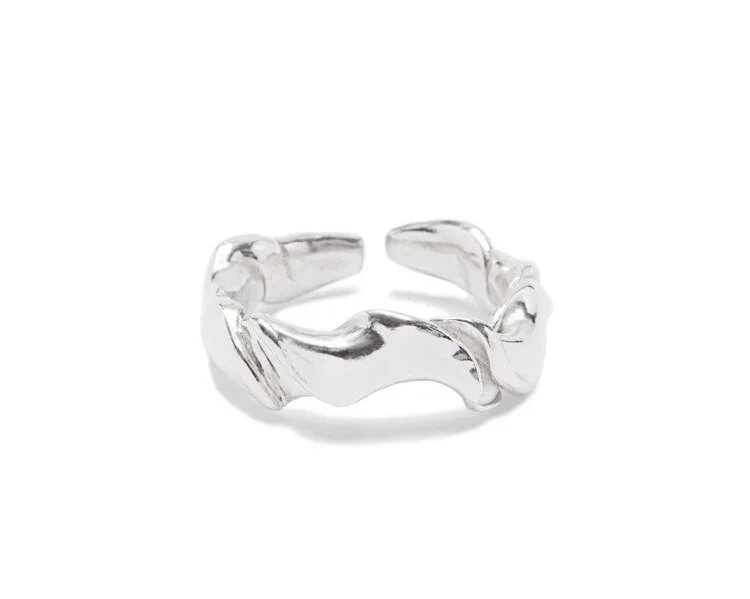What You Need to Know About Recycled Silver
Recently Kate Middleton was spotted wearing jewellery made from 100% recycled silver on her visit to Copenhagen, showing not only the important steps that the industry is taking to switch to recycled metals, but also that the mainstream are ready for it. And we couldn't be happier! It got us thinking of all the benefits of recycled silver for both people and planet and our designers who give it a new lease of life.
From saving plants, wildlife and habitats, to reducing CO2 emissions, toxic waste and energy, recycled silver offers a more sustainable solution to jewellery creation. It also gives a second life to unused scraps, and may even give silver trapped in our dowdy electronics a chance to shine. Here are just a few reasons to love recycled silver...
Emma Aitchison Jewellery
1.Recycled silver is just as good quality as virgin silver
No purity is lost in the process of extracting silver from used items. Impurities are extracted in the process leaving behind the same pure silver that was originally used.
2. Recycling silver helps to save a vast amount of energy and carbon emissions
Metal mining uses a huge amount of energy to extract metal ore, as well as emitting greenhouses gasses through its smelting and processing operations. Using recycled silver skips this entire process, saving 95% more energy compared to using raw materials. The Institute of Scrap Recycling Industries further claims that recycling metal can cut harmful emissions by between 300 - 500 million tons.
3. The use of recycled silver can reduce deforestation and habitat destruction.
Metal mines require thousands of acres of land. To make space for their operations space many metal mines have slashed and burned rainforest including the Amazon, leaving a devastating loss of habitat for plants and wildlife and pollution to the ecosystem. Furthermore, waste minerals and rocks have been known to become toxic through acid drainage, for example in The Grasberg Mine in Papua, which then seeps into the air and water, further damaging habitats. Recycling metal reduces mining waste by 97% according to Green Matters.
4. The social cost of metal mining can be high
Silver mining often takes place in developing nations, but with limited consultation with the local communities. One particular harmful consequence of silver production is large emissions of mercury to the air, soil and water, particularly where silver is extracted by small-scale miners. The physical environment is also of course hugely impacted by the mine’s life cycle of excavating, construction, operation, maintenance, mine expansion, abandonment, decommissioning and repurposing of a mine. Both these things not only impact the way of life and social systems of the local communities, but also have serious health implications.
5. Recycled silver can come from many forms, not just unused jewellery.
Silver is one of the most useful metals in the world, with its properties reaching much further than its aesthetics. It is the best thermal and electrical conductor, is ductile and malleable, and is antibacterial and antimicrobial making it incredibly useful in a wide range of industrial, technological any medical products. You may be surprised at the variety of items that you can extract silver from, including coins, electronics, cameras, kitchenware, engine components, medical equipment and even photographs can all be recycled for silver. Jewellery is only the tip of the iceberg for this versatile material.
6. There are two ways that silver can be recycled
There are two types of silver recycling that are most commonly used - Small and large scale recycling. Small scale silver recycling is done by hand by skilled workers using traditional methods in a time-consuming process, while large scale recycling takes place on a commercial scale at an industrial level. Both methods essentially involve melting the silver then different approaches are taken to separate the metals further including use of acids, applying heat or using an electric current.
7. You can recycle silver you have at home
There are ways you can recycle your own silver from unused items from your home, and even make some money back as well as contribute to the reduction of harmful mining. If you’d like to get a little cash back for your silver, search for your local silver dealer who will melt and reuse your metal items. Some jewellery shops will buy your silver to melt and recast into new pieces, usually for the value in weight. If you'd like to give back to charity but your jewellery isn't suitable for re-sale, Recycling for Good Causes will recycle them to raise funds for charity. For electronic and household items, simply drop them at your local collection centre and who knows, the silver in your TV may just be turned into beautiful jewels instead of end up in landfill! Even old photos can be stripped of their silver using electrolysis. Recycle Now has some great advice to get started.
We are proud that the majority of designers at Seekd already incorporate recycled materials into their collections, alongside other eco-considerations. Visit the Designers page to learn more about their ethics and methods.
All Its Forms
Orchesa



